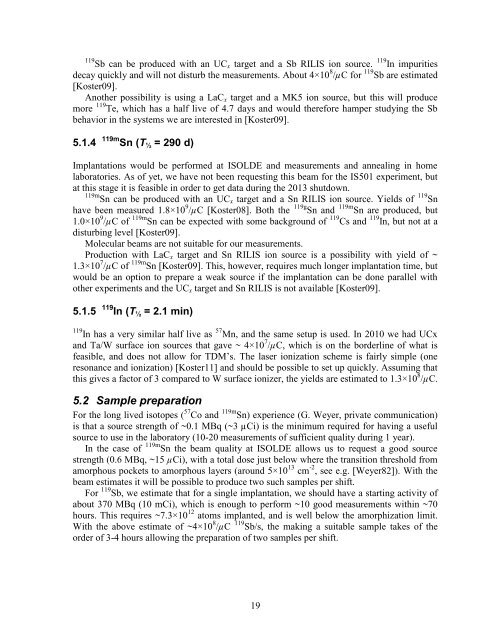INTC-2012-005/INTC-P-275-ADD-1 - CERN Document Server
INTC-2012-005/INTC-P-275-ADD-1 - CERN Document Server
INTC-2012-005/INTC-P-275-ADD-1 - CERN Document Server
Create successful ePaper yourself
Turn your PDF publications into a flip-book with our unique Google optimized e-Paper software.
119 Sb can be produced with an UCx target and a Sb RILIS ion source. 119 In impurities<br />
decay quickly and will not disturb the measurements. About 4×10 8 /µC for 119 Sb are estimated<br />
[Koster09].<br />
Another possibility is using a LaCx target and a MK5 ion source, but this will produce<br />
more 119 Te, which has a half live of 4.7 days and would therefore hamper studying the Sb<br />
behavior in the systems we are interested in [Koster09].<br />
5.1.4 119m Sn (T½ = 290 d)<br />
Implantations would be performed at ISOLDE and measurements and annealing in home<br />
laboratories. As of yet, we have not been requesting this beam for the IS501 experiment, but<br />
at this stage it is feasible in order to get data during the 2013 shutdown.<br />
119m Sn can be produced with an UCx target and a Sn RILIS ion source. Yields of 119 Sn<br />
have been measured 1.8×10 9 /µC [Koster08]. Both the 119g Sn and 119m Sn are produced, but<br />
1.0×10 9 /µC of 119m Sn can be expected with some background of 119 Cs and 119 In, but not at a<br />
disturbing level [Koster09].<br />
Molecular beams are not suitable for our measurements.<br />
Production with LaCx target and Sn RILIS ion source is a possibility with yield of ~<br />
1.3×10 7 /µC of 119m Sn [Koster09]. This, however, requires much longer implantation time, but<br />
would be an option to prepare a weak source if the implantation can be done parallel with<br />
other experiments and the UCx target and Sn RILIS is not available [Koster09].<br />
5.1.5 119 In (T½ = 2.1 min)<br />
119 In has a very similar half live as 57 Mn, and the same setup is used. In 2010 we had UCx<br />
and Ta/W surface ion sources that gave ~ 4×10 7 /µC, which is on the borderline of what is<br />
feasible, and does not allow for TDM’s. The laser ionization scheme is fairly simple (one<br />
resonance and ionization) [Koster11] and should be possible to set up quickly. Assuming that<br />
this gives a factor of 3 compared to W surface ionizer, the yields are estimated to 1.3×10 8 /µC.<br />
5.2 Sample preparation<br />
For the long lived isotopes ( 57 Co and 119m Sn) experience (G. Weyer, private communication)<br />
is that a source strength of ~0.1 MBq (~3 µCi) is the minimum required for having a useful<br />
source to use in the laboratory (10-20 measurements of sufficient quality during 1 year).<br />
In the case of 119m Sn the beam quality at ISOLDE allows us to request a good source<br />
strength (0.6 MBq, ~15 µCi), with a total dose just below where the transition threshold from<br />
amorphous pockets to amorphous layers (around 5×10 13 cm -2 , see e.g. [Weyer82]). With the<br />
beam estimates it will be possible to produce two such samples per shift.<br />
For 119 Sb, we estimate that for a single implantation, we should have a starting activity of<br />
about 370 MBq (10 mCi), which is enough to perform ~10 good measurements within ~70<br />
hours. This requires ~7.3×10 12 atoms implanted, and is well below the amorphization limit.<br />
With the above estimate of ~4×10 8 /µC 119 Sb/s, the making a suitable sample takes of the<br />
order of 3-4 hours allowing the preparation of two samples per shift.<br />
19















